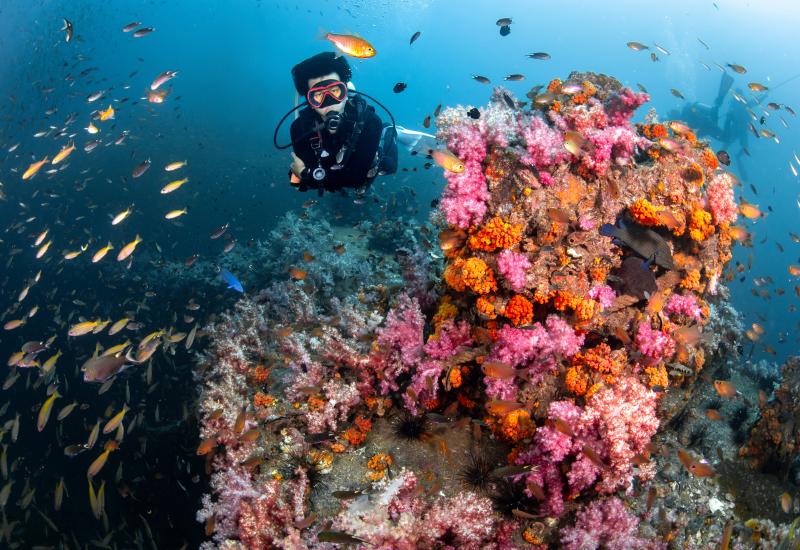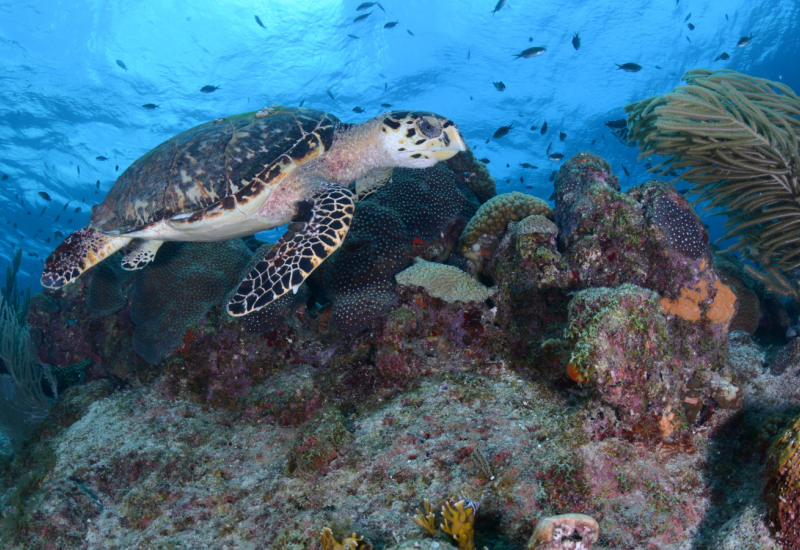The Grand Dame of Florida Wreck Diving: USS Spiegel Grove
Florida’s dive sites are all within relatively short travel distances. For instance, it’s possible to dive with lemon sharks in Jupiter in the morning, drift dive with sea turtles over the reefs of Palm Beach in the afternoon, and explore the wrecks and reefs of the Florida Keys the next day. However, of all the options available to divers, it is the variety of shipwrecks that draws the most attention to the state, and for the past decade, the centerpiece of Florida wreck diving has been the USS Spiegel Grove.
Click below to see a video of the USS Spiegel Grove:
TITLE HOLDER
At the time of its sinking as an artificial reef in May of 2002, the 510-foot-long and 85-foot-wide Spiegel Grove (LSD-32), a former Loading Ship Dock originally constructed in September 1954, was the largest deliberately placed artificial reef in the world. Since that time, her title of “the biggest” fell to the USS Oriskany off Florida’s Gulf Coast in 2006, and the recent sinking of the 520-foot-long USNS Vandenberg near Key West has stolen a bit of the Spiegel Grove’s thunder, but she still remains one of the world’s premier wreck diving sites.
The vessel has had an interesting ride to get to her current place among Florida’s big shipwrecks, starting with the ship’s premature sinking. Originally scheduled for sinking on Friday afternoon the 17th of May 2002, the vessel apparently decided not to wait for the salvage crews and, six hours early, began to go down on its own, rolling over and coming to rest upside down with her bow protruding from the water. Three weeks later, salvage crews managed to complete the sinking of the Spiegel Grove, but were unable to roll the vessel upright and she came to rest on her starboard side. Further efforts were made to right the ship, without success, and the dive community eventually came to accept the fact that the vessel would remain on its side. Nature had other ideas, however, and in July of 2005, Hurricane Dennis ripped across the Florida Keys, leaving the Spiegel Grove sitting upright on the ocean’s bottom, just as originally planned.
THE DIVE
Unlike her younger cousin, the USNS Vandenberg, the Spiegel Grove is a fully developed reef ecosystem. Thick coral covers the huge cranes and the gun mounts and carpets the decks, and numerous reef creatures, from queen angelfish to barracuda, inhabit the nooks and crannies of the vessel. The vessel is considered an advanced wreck diving site, with all of its primary structure at 60 feet or deeper and frequent strong currents across the site. There are numerous openings into the upper decks of the vessel, but as with any confined or overhead environment divers should never enter those areas without proper training and experience. The access provided to the ship’s interior through these openings, however, has made the vessel very popular with experienced technical and wreck penetration divers.
Exterior
The exterior of the vessel provides divers with a diverse landscape to explore, and the majority of the structures can be seen on a single day’s “double-dip” charter for those looking to just make the rounds. Numerous mooring balls provide the means for both the tying off of visiting charter boats, and secure descent lines for the divers. Three of these lines end at depths between 60 and 70 feet, those attached to the port side of the upper superstructure and the tops of the large cranes, and several others on the bow and stern that terminate in deeper depths of 90 to 100 feet. The vessel itself sits in 134 feet of water with the top of the wheelhouse around 60 feet, the peak of the bow at 90 feet, and the top of the stern deck near the well door at 100 feet. There have been up to eight moorings on the site, but not all of those remain as of my last visit to the site.
Bow
The bow of the vessel is a wide open space with the most prominent feature being the large double capstan anchor system, that is actually in use as the ship’s anchors and chain are placed out in front of the vessel to help keep it stabilized on the bottom. Moving aft, the superstructure rises up from the foredeck, with divers passing deck reels, numerous open hatches, and one coral encrusted twin 50 caliber gun mount as they ascend to the decks surrounding the Maneuvering Bridge. Rolling around to the port side of the superstructure, divers will find three bronze plaques commemorating the final duty station of the vessel and listing the names of significant donors to the project. Heading aft along the top weather decks at around 70 feet of depth, divers encounter the forward exhaust stack, two more coral-encrusted gun mounts, deck reels, and the control tower looking down into the open well deck from the back end of the main superstructure.
Aft
Moving aft into the well deck area, the most dominant structures are the aft exhaust stack on the port side, and the port and starboard 50-ton cranes, the lattice structures of which are heavily encrusted with coral and home to colorful reef fish. The large well deck is almost completely open at the top with just one section of the former helicopter platform remaining as a bridge between the port and starboard hull sides. Reaching the rear of the ship, the enormous well door lies open, as if waiting for landing craft to return onboard.
QUEEN OF THE COAST
As the grand matron of Florida shipwrecks, the USS Spiegel Grove continues to be a perennial favorite of local and visiting divers alike. Often presenting a challenge to even the most experienced divers with the strong currents that run across her decks, the diversity of her growing coral ecosystem and the thrill of exploring her decks and spaces will continue draw the adventurous — and curious — among us.
Florida’s dive sites are all within relatively short travel distances. For instance, it’s possible to dive with lemon sharks in Jupiter in the morning, drift dive with sea turtles over the reefs of Palm Beach in the afternoon, and explore the wrecks and reefs of the Florida Keys the next day. However, of all the options available to divers, it is the variety of shipwrecks that draws the most attention to the state, and for the past decade, the centerpiece of Florida wreck diving has been the USS Spiegel Grove.
Click below to see a video of the USS Spiegel Grove:
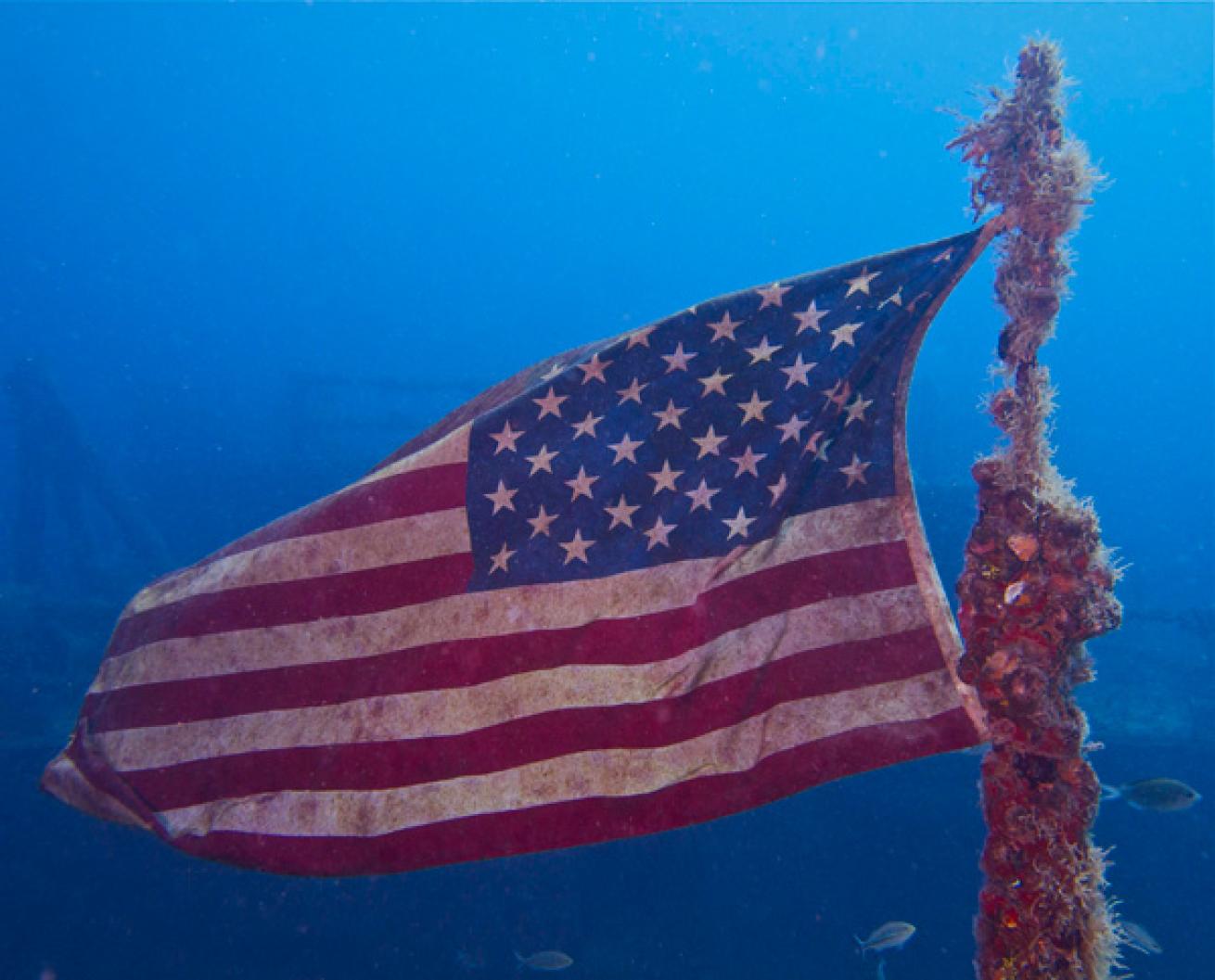
Floyd Devine.
TITLE HOLDER
At the time of its sinking as an artificial reef in May of 2002, the 510-foot-long and 85-foot-wide Spiegel Grove (LSD-32), a former Loading Ship Dock originally constructed in September 1954, was the largest deliberately placed artificial reef in the world. Since that time, her title of “the biggest” fell to the USS Oriskany off Florida’s Gulf Coast in 2006, and the recent sinking of the 520-foot-long USNS Vandenberg near Key West has stolen a bit of the Spiegel Grove’s thunder, but she still remains one of the world’s premier wreck diving sites.
The vessel has had an interesting ride to get to her current place among Florida’s big shipwrecks, starting with the ship’s premature sinking. Originally scheduled for sinking on Friday afternoon the 17th of May 2002, the vessel apparently decided not to wait for the salvage crews and, six hours early, began to go down on its own, rolling over and coming to rest upside down with her bow protruding from the water. Three weeks later, salvage crews managed to complete the sinking of the Spiegel Grove, but were unable to roll the vessel upright and she came to rest on her starboard side. Further efforts were made to right the ship, without success, and the dive community eventually came to accept the fact that the vessel would remain on its side. Nature had other ideas, however, and in July of 2005, Hurricane Dennis ripped across the Florida Keys, leaving the Spiegel Grove sitting upright on the ocean’s bottom, just as originally planned.
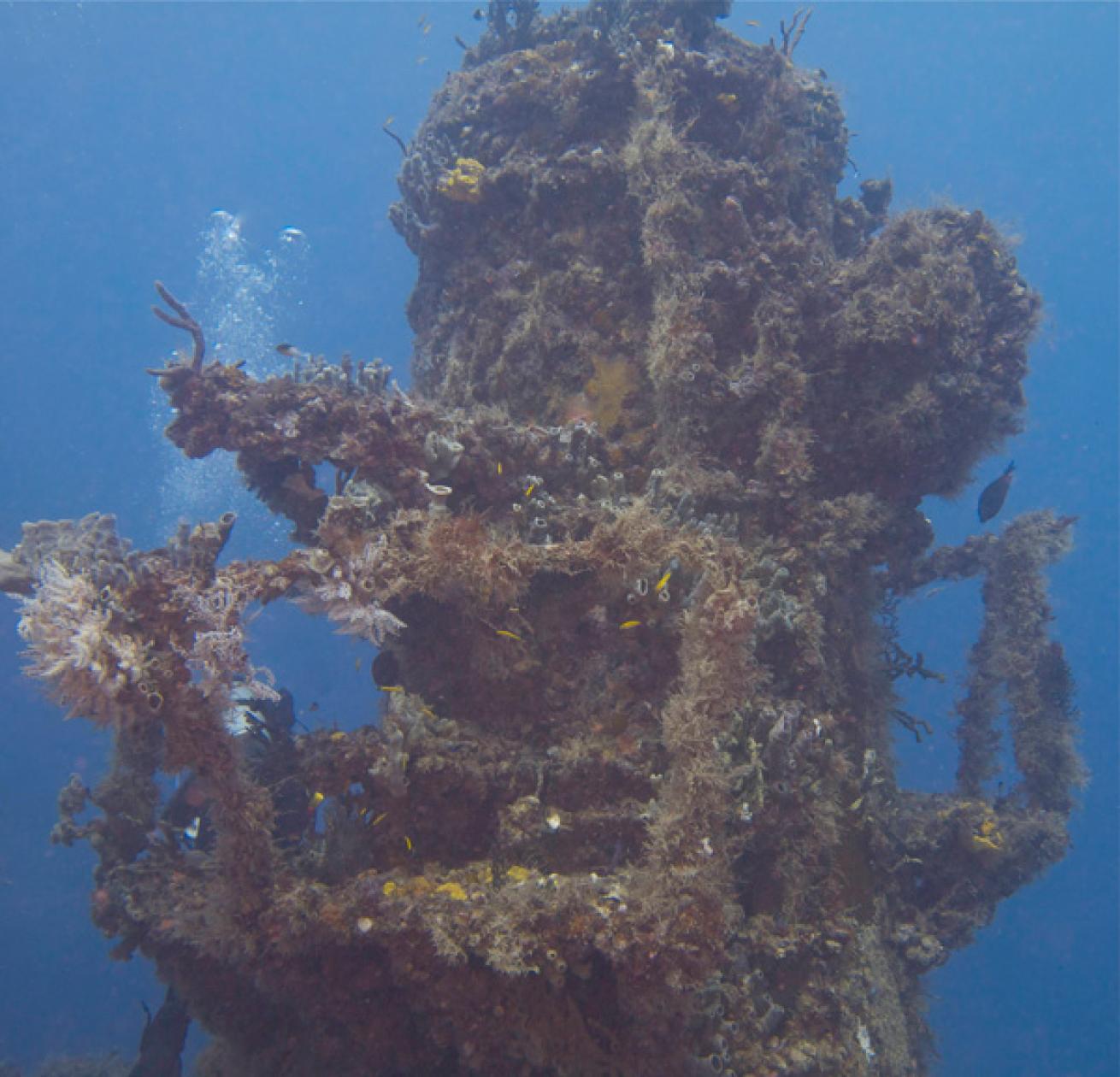
Floyd Devine.
THE DIVE
Unlike her younger cousin, the USNS Vandenberg, the Spiegel Grove is a fully developed reef ecosystem. Thick coral covers the huge cranes and the gun mounts and carpets the decks, and numerous reef creatures, from queen angelfish to barracuda, inhabit the nooks and crannies of the vessel. The vessel is considered an advanced wreck diving site, with all of its primary structure at 60 feet or deeper and frequent strong currents across the site. There are numerous openings into the upper decks of the vessel, but as with any confined or overhead environment divers should never enter those areas without proper training and experience. The access provided to the ship’s interior through these openings, however, has made the vessel very popular with experienced technical and wreck penetration divers.
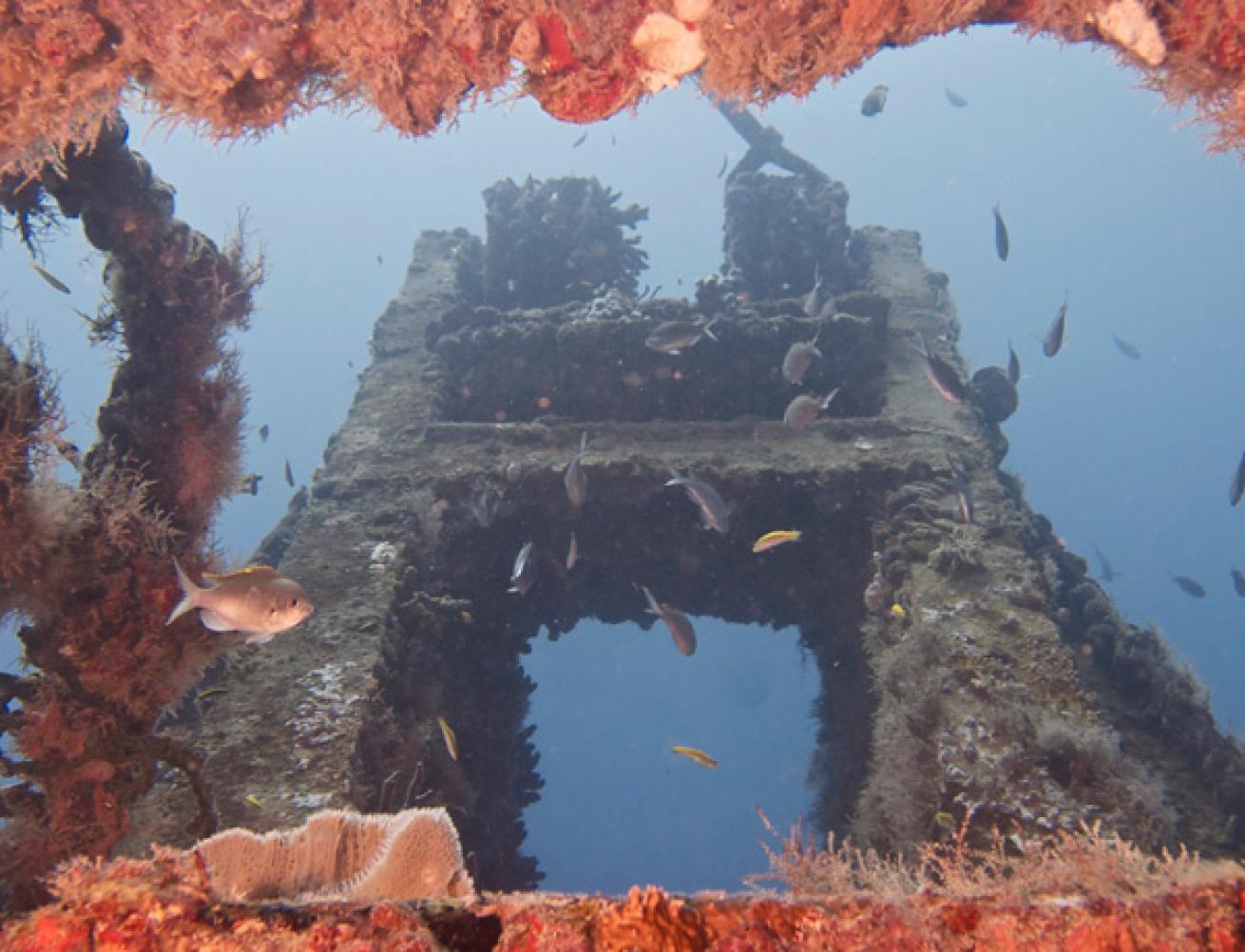
Floyd Devine.
Exterior
The exterior of the vessel provides divers with a diverse landscape to explore, and the majority of the structures can be seen on a single day’s “double-dip” charter for those looking to just make the rounds. Numerous mooring balls provide the means for both the tying off of visiting charter boats, and secure descent lines for the divers. Three of these lines end at depths between 60 and 70 feet, those attached to the port side of the upper superstructure and the tops of the large cranes, and several others on the bow and stern that terminate in deeper depths of 90 to 100 feet. The vessel itself sits in 134 feet of water with the top of the wheelhouse around 60 feet, the peak of the bow at 90 feet, and the top of the stern deck near the well door at 100 feet. There have been up to eight moorings on the site, but not all of those remain as of my last visit to the site.
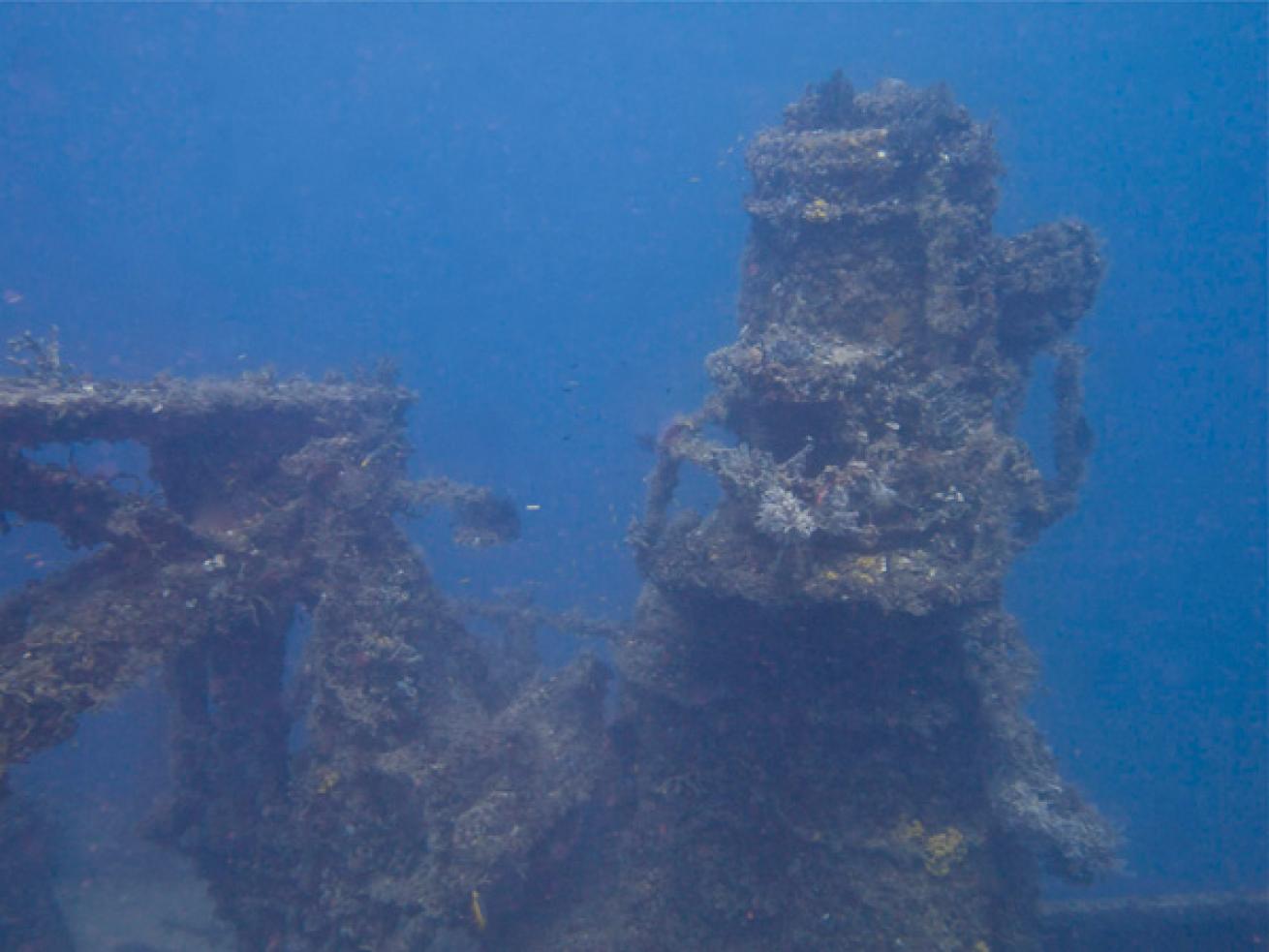
Floyd Devine.
Bow
The bow of the vessel is a wide open space with the most prominent feature being the large double capstan anchor system, that is actually in use as the ship’s anchors and chain are placed out in front of the vessel to help keep it stabilized on the bottom. Moving aft, the superstructure rises up from the foredeck, with divers passing deck reels, numerous open hatches, and one coral encrusted twin 50 caliber gun mount as they ascend to the decks surrounding the Maneuvering Bridge. Rolling around to the port side of the superstructure, divers will find three bronze plaques commemorating the final duty station of the vessel and listing the names of significant donors to the project. Heading aft along the top weather decks at around 70 feet of depth, divers encounter the forward exhaust stack, two more coral-encrusted gun mounts, deck reels, and the control tower looking down into the open well deck from the back end of the main superstructure.

Floyd Devine.
Aft
Moving aft into the well deck area, the most dominant structures are the aft exhaust stack on the port side, and the port and starboard 50-ton cranes, the lattice structures of which are heavily encrusted with coral and home to colorful reef fish. The large well deck is almost completely open at the top with just one section of the former helicopter platform remaining as a bridge between the port and starboard hull sides. Reaching the rear of the ship, the enormous well door lies open, as if waiting for landing craft to return onboard.
QUEEN OF THE COAST
As the grand matron of Florida shipwrecks, the USS Spiegel Grove continues to be a perennial favorite of local and visiting divers alike. Often presenting a challenge to even the most experienced divers with the strong currents that run across her decks, the diversity of her growing coral ecosystem and the thrill of exploring her decks and spaces will continue draw the adventurous — and curious — among us.

